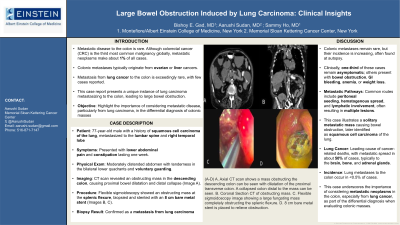Sunday Poster Session
Category: Colon
P0272 - Large Bowel Obstruction Induced by Lung Carcinoma: Clinical Insights
Sunday, October 27, 2024
3:30 PM - 7:00 PM ET
Location: Exhibit Hall E

Has Audio

Aarushi Sudan, MD
NYC Health + Hospitals/Jacobi
New York, NY
Presenting Author(s)
Bishoy E. Gad, MD1, Aarushi Sudan, MD2, Sammy Ho, MD, FACG3
1Montefiore Medical Center, Albert Einstein College of Medicine, Bronx, NY; 2NYC Health + Hospitals/Jacobi, New York, NY; 3Montefiore Medical Center, New York, NY
Introduction: Metastatic disease to the colon is a rare clinical entity. Although Colorectal cancer is the third most frequent malignancy worldwide, metastatic neoplasms make up only about 1% of all colorectal cancers. Primary neoplasms of the ovaries and liver have been implicated in the majority of cases. Only a handful of cases in the literature have been documented where metastatic invasion of the colon was seen secondary to lung cancer. This case report describes an atypical location of metastasis from lung cancer.
Case Description/Methods: A 77-year-old man with squamous cell carcinoma of the lung, with metastases to the lumbar spine and right temporal lobe, presented with a week of lower abdominal pain and constipation. Physical exam was notable for a moderately distended abdomen tender to palpation in the bilateral lower quadrants with voluntary guarding. CT imaging showed an obstructing mass in the descending colon, causing large bowel dilatation proximal to the mass and a collapsed colon distal to the site. (image A). Due to concern for bowel obstruction, a flexible sigmoidoscopy was performed, revealing an obstructing mass at the splenic flexure, which was biopsied and stented using an 8 cm bare metal stent (Images B, C). A biopsy confirmed the mass as a metastasis from lung carcinoma.
Discussion: Although colonic metastases are rare, their incidence appears to be increasing, with a greater proportion found at autopsy. Clinically, nearly a third of these masses remain asymptomatic, but in the other two-thirds of cases, they may present with bowel obstruction, GI bleeding, anemia, and weight loss. Most cases present as multiple lesions due to the preferred metastatic pathways of peritoneal seeding, hematogenous spread, or lymphatic involvement. This study illustrates a solitary metastatic mass in the colon leading to bowel obstruction, later identified as arising from squamous cell carcinoma of the lung.
Lung cancer is the leading cause of cancer-related deaths worldwide, with metastatic disease seen in about 50% of cases, typically spreading to the brain, bone, and adrenal glands. However, it is extremely uncommon for lung cancers to metastasize to the colon, with an incidence of less than 0.5%. By sharing our experience, we aim to highlight the importance of considering metastatic neoplasms in the colon, particularly those originating from lung cancer, as an important differential diagnosis when evaluating colonic masses.

Disclosures:
Bishoy E. Gad, MD1, Aarushi Sudan, MD2, Sammy Ho, MD, FACG3. P0272 - Large Bowel Obstruction Induced by Lung Carcinoma: Clinical Insights, ACG 2024 Annual Scientific Meeting Abstracts. Philadelphia, PA: American College of Gastroenterology.
1Montefiore Medical Center, Albert Einstein College of Medicine, Bronx, NY; 2NYC Health + Hospitals/Jacobi, New York, NY; 3Montefiore Medical Center, New York, NY
Introduction: Metastatic disease to the colon is a rare clinical entity. Although Colorectal cancer is the third most frequent malignancy worldwide, metastatic neoplasms make up only about 1% of all colorectal cancers. Primary neoplasms of the ovaries and liver have been implicated in the majority of cases. Only a handful of cases in the literature have been documented where metastatic invasion of the colon was seen secondary to lung cancer. This case report describes an atypical location of metastasis from lung cancer.
Case Description/Methods: A 77-year-old man with squamous cell carcinoma of the lung, with metastases to the lumbar spine and right temporal lobe, presented with a week of lower abdominal pain and constipation. Physical exam was notable for a moderately distended abdomen tender to palpation in the bilateral lower quadrants with voluntary guarding. CT imaging showed an obstructing mass in the descending colon, causing large bowel dilatation proximal to the mass and a collapsed colon distal to the site. (image A). Due to concern for bowel obstruction, a flexible sigmoidoscopy was performed, revealing an obstructing mass at the splenic flexure, which was biopsied and stented using an 8 cm bare metal stent (Images B, C). A biopsy confirmed the mass as a metastasis from lung carcinoma.
Discussion: Although colonic metastases are rare, their incidence appears to be increasing, with a greater proportion found at autopsy. Clinically, nearly a third of these masses remain asymptomatic, but in the other two-thirds of cases, they may present with bowel obstruction, GI bleeding, anemia, and weight loss. Most cases present as multiple lesions due to the preferred metastatic pathways of peritoneal seeding, hematogenous spread, or lymphatic involvement. This study illustrates a solitary metastatic mass in the colon leading to bowel obstruction, later identified as arising from squamous cell carcinoma of the lung.
Lung cancer is the leading cause of cancer-related deaths worldwide, with metastatic disease seen in about 50% of cases, typically spreading to the brain, bone, and adrenal glands. However, it is extremely uncommon for lung cancers to metastasize to the colon, with an incidence of less than 0.5%. By sharing our experience, we aim to highlight the importance of considering metastatic neoplasms in the colon, particularly those originating from lung cancer, as an important differential diagnosis when evaluating colonic masses.

Figure: (A-D) A. Axial CT scan shows a mass obstructing the descending colon can be seen with dilatation of the proximal transverse colon. A collapsed colon distal to the mass can be seen. B. Coronal Section CT of obstructing mass. C. Flexible sigmoidoscopy image showing a large fungating mass completely obstructing the splenic flexure. D. 8 cm bare metal stent is placed to relieve obstruction.
Disclosures:
Bishoy Gad indicated no relevant financial relationships.
Aarushi Sudan indicated no relevant financial relationships.
Sammy Ho indicated no relevant financial relationships.
Bishoy E. Gad, MD1, Aarushi Sudan, MD2, Sammy Ho, MD, FACG3. P0272 - Large Bowel Obstruction Induced by Lung Carcinoma: Clinical Insights, ACG 2024 Annual Scientific Meeting Abstracts. Philadelphia, PA: American College of Gastroenterology.
